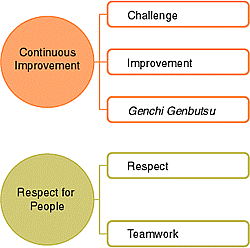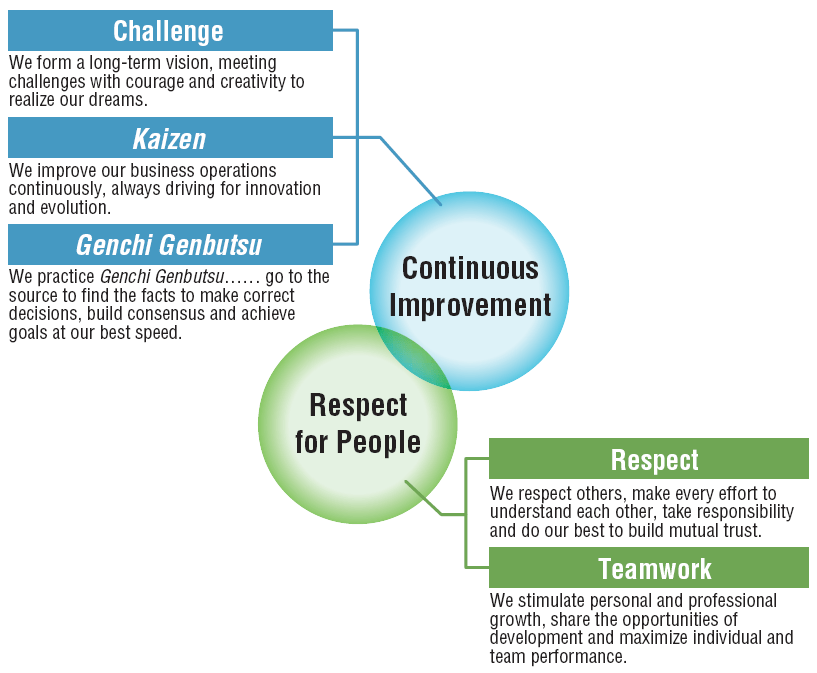Background: I wrote this article as a response to what was then (early 2000s) the still-strong focus on “Continuous Improvement” while neglecting “Respect for People.” The article was first published in 2009 on The Lean CEO, a website created by Kevin Meyer. I was a frequent contributor to The Lean CEO, with most of the articles later published in my six-volume REAL LEAN book series (published from 2007 to 2010) and the book Lean Is Not Mean. The article below was published in REAL LEAN: Strategies for Lean Management Success, Volume Five (2010). Interest in “Respect for People” finally began to blossom between 2010 and 2014. Since then, “Respect for People” has become so prominent in Lean world as to replace the primary focus of TPS which is Just-in-Time, and the method for achieving TPS, kaizen. 😒
Just about everyone interested in Lean management has by now heard of The Toyota Way. But have you ever heard of The Toyota Half-Way? Probably not, but that is exactly what most people are doing in their Lean activities.
In April 2001, Toyota Motor Corporation produced a document for internal use called “The Toyota Way 2001” [1]. It is a 13-page booklet, produced at the request of the then-president Fujio Cho, that describes the unique aspects of Toyota’s culture which contributed to its success. The document was produced to help ensure a consistent understanding of The Toyota Way among all associates in response to the rapid growth and globalization of Toyota Motor Corporation.
However, as Mr. Kazuhara, the general manager of final assembly Toyota’s Motomachi plant told me on 14 June 2001, the fact that The Toyota Way has been written down means nothing: “Words are just words, there is more to it [the Toyota Way] than just words.” He said it is the responsibility of each supervisor to bring The Toyota Way to life through daily practice and train future generations of managers and associates on-the-job [2].\

There are two main pillars of The Toyota Way: “Continuous Improvement” and “Respect for People,” as shown in the figure on the right [3]. “Continuous Improvement” consists of three elements: challenge, improvement, and genchi genbutsu (go to the source), while “Respect for People” consists of two elements, respect and teamwork. These principles and the five elements are deeply rooted in Toyota’s history and the Toyoda family’s logical and reality-based philosophy of business. These principles, however, are not new and have long been associated with progressive management [4].
The image below represents the full extent of publicly available information on The Toyota Way from Toyota Motor Corporation since 2001 [5]. The two principles and the definitions associated with each of the five elements are just the beginning of much more complete descriptions. It is very important to understand that Toyota does not use a single definition for either of the two principles or for each of the five elements. It uses many definitions and includes real-world examples. Together these create broad descriptions rather than discrete definitions. So please don’t go looking for simple definitions where none exist. You have to think for yourself and apply the “Continuous Improvement” and “Respect for People” principles at work every day to learn what they mean.

Today there are numerous books that have the words “The Toyota Way” as the title or subtitle. Surprisingly, all of them focus mostly or exclusively on the “Continuous Improvement” principle. What happened to the “Respect for People” principle? Why is one of the two pillars that are necessary to make Lean management work left out?
The fact that this principle or deep discussion of it, both stand-alone and in relation to the “Continuous Improvement” principle, is missing is not a trivial matter. It is in fact vitally important because throughout the history of progressive management, of which Lean is the current best example, executives have almost always focused solely on continuous improvement – the tools [6] – and ignored the “Respect for People” principle (or its equivalent in earlier times) [7].
If all we do is pay attention to the “Continuous Improvement” principle, then we are in fact following the Toyota Half-Way. Doing so won’t even yield half the results. You might get 20% of the benefits if you try really hard.

To ignore the “Respect for People” principle is to assure a lot of work and very little actual improvement.
Senior managers always stumble on the “Respect for People” principle because they think this principle is trivial, that they already respect people, or that it can only be put into practice at great cost. Those assumptions are incorrect. For example, if you think shareholders matter more than any other stakeholder, then you do not understand the “Respect for People” principle. If you think purchase price variance and earned hours are good performance metrics, then you do not understand the “Respect for People” principle. If you think that winning at someone else’s expense is OK, then you do not understand the “Respect for People” principle. When Lean transformations fail, simple root cause analysis always points to a failure by executives to understand and apply the “Respect for People” principle.
The “Respect for People” principle is understood only through daily practice, on-the-job. It requires years of thought to understand well and can never be completely comprehended. That should be an inspiration, not a deterrent. Along the way, you will realize great results. Now that’s a challenge worthy of those who receive big paychecks.
If you are part of a management team, supervisor on up, then it is your responsibility to bring the “Continuous Improvement” and “Respect for People” principles to life by practicing them every day, and to train subordinates so that they in turn can train future generations of managers and associates.
One of Toyota’s great accomplishments has been to build upon the work of others before them and add their own important ideas and inventions to create a beautiful, carefully integrated management system, steadily improving it day-by-day, and then maintaining commitment to it through generations of managers [8]. It is a shame to see it cherry-picked time and time again, for the purpose of expediency, and become The Toyota Half-Way in nearly every organization [9].
Please remember that the “Respect for People” principle is not optional. Lean management cannot function properly without it. This principle is everyone’s weakness and must now become your focus [10].
___________
Notes
[1] “The Toyota Way 2001,” Toyota Motor Corporation, internal document, Toyota City, Japan, April 2001
[2] He also said that once important things are written down they then become unchangeable, and there is a danger in The Toyota Way becoming viewed as unchangeable. The Toyota Way must evolve and adapt over time in response to reality.
[3] “Toyota Environmental and Social Report 2003,” Toyota Motor Corporation, Toyota City, Japan, http://www.toyota.co.jp/en/environmental_rep/03/jyugyoin/image15.gif
[4] See “The Equally Important Respect for People Principle” by Bob Emiliani, http://www.theclbm.com/respect_for_people.pdf
[5] “Toyota Sustainability Report 2006,” Toyota Motor Corporation, Toyota City, Japan, http://www.toyota.co.jp/en/environmental_rep/06/download/pdf/e_report06_p49_p55.pdf
[6] Where the tools include: value stream maps, A3 reports, policy deployment, standardized work, 5 Whys, Just-In-Time, visual workplace, set-up reduction, etc.
[7] B. Emiliani, REAL LEAN: The Keys to Sustaining Lean Management, Volume Three, The CLBM, LLC, Wethersfield, Conn., 2008, pp. 212-237
[8] However, it is clear Toyota has stumbled badly in recent years. Their self-imposed high growth period from 1998-2008 seems to be the key factor that has led to numerous problems that will be difficult to correct.
[9] In some departments – such as Finance, Sales, Marketing, Legal, Human Resources, etc. – you will find the “Toyota No-Way,” meaning they have zero interest in improving their business process using Lean principles and practices.
[10] This workbook will help you understand the “Respect for People” principle: B. Emiliani, Practical Lean Leadership: A Strategic Leadership Guide for Executives, The CLBM, LLC, Wethersfield, Conn., 2008. So will Better Thinking, Better Results: Case Study and Analysis of an Enterprise-Wide Lean Transformation, B. Emiliani, with D. Stec, L. Grasso, and J. Stodder, second edition, The CLBM, LLC, Wethersfield, Conn., 2007. This is the first book to describe an enterprise-wide Lean transformation in a real company where both principles of Lean management – “Continuous Improvement” and “Respect for People” – were applied.
